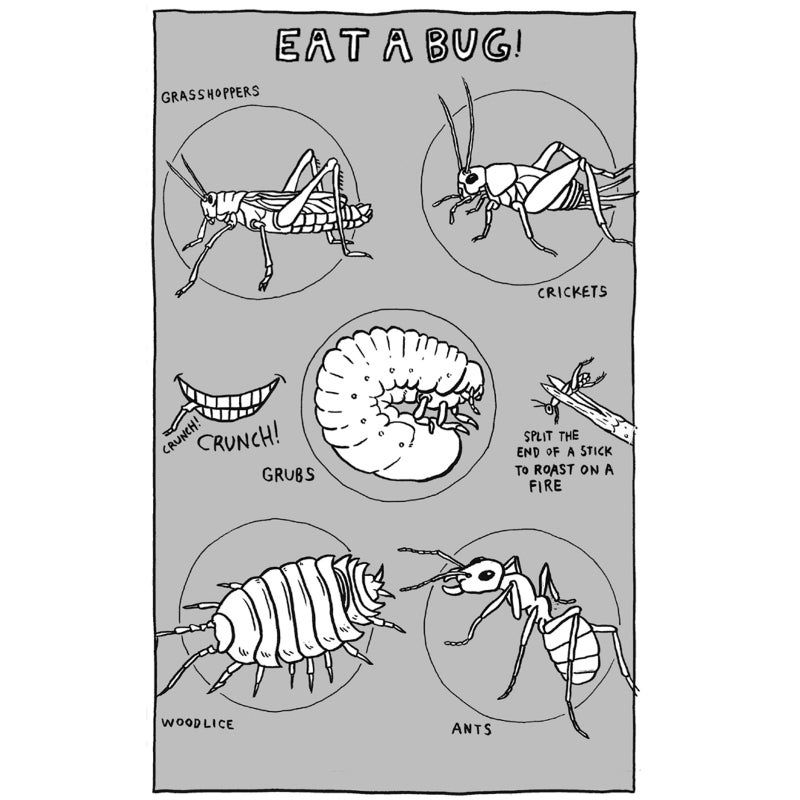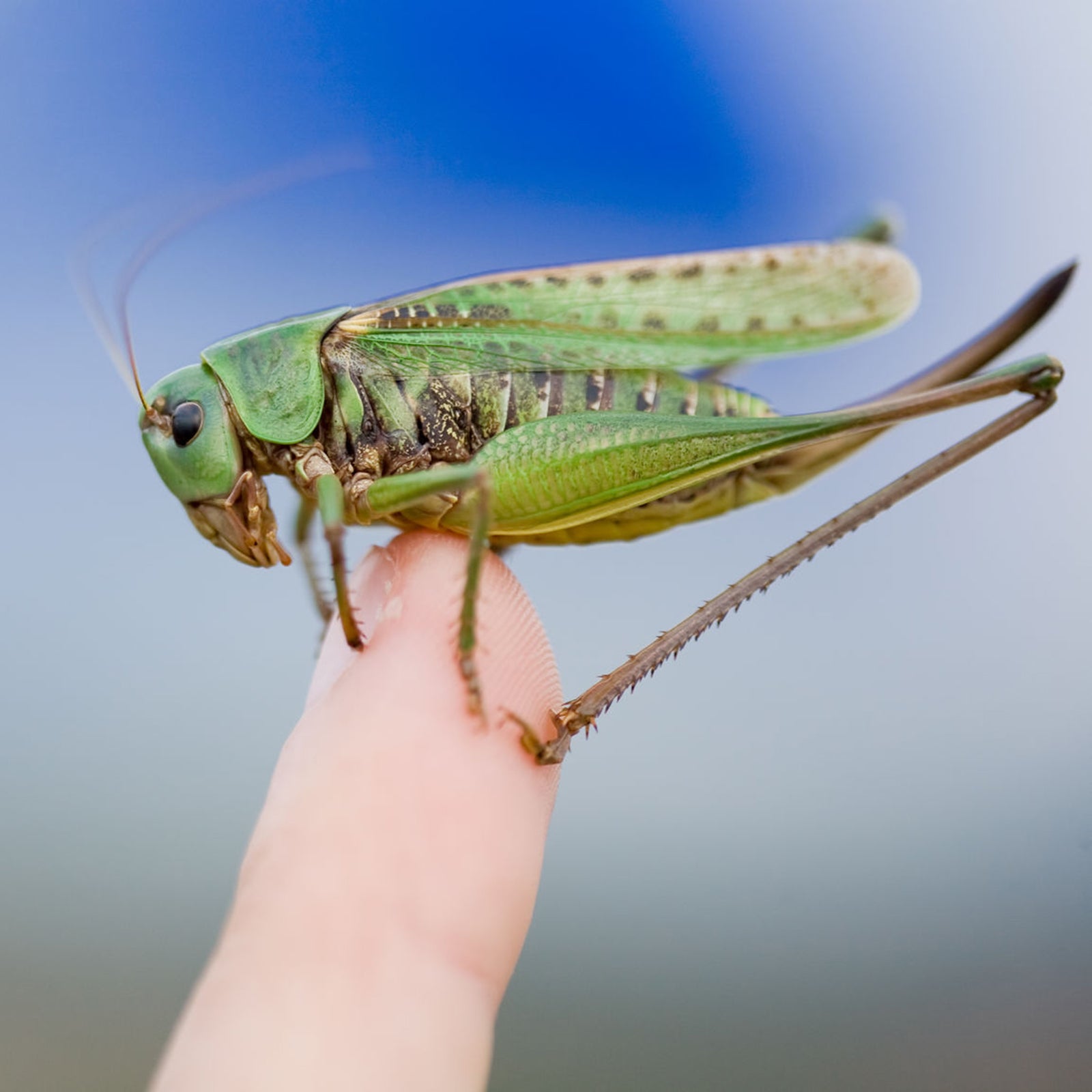Here’s something you may not want to know about eating insects, but we're going to tell you, anyway: you already are. That’s because food manufacturers are legally allowed a certain number of “defects” in their products, which includes insects. For instance, an 8-ounce handful of raisins might contain up to 35 fruit fly eggs, and 240 “pests” are allowed in each 12-ounce bag of frozen broccoli (what we want to know is: who’s doing the counting?). “OK, fine,” you say. “I never liked raisins and broccoli all that much anyhow. I’ll just eat chocolate instead.” In which case, you should know that a chocolate bar is allowed eight insect parts. And no, you don’t get to choose which ones.

Truth is, this isn’t really such a bad thing, because insects are loaded with the vital macronutrients of protein and fat. And tasty? Whoo-eee, yes. You haven’t lived until you’ve tried grasshoppers fried in soy sauce. Did you know that 80 percent of the world’s population eats over one thousand species of insects? Well, now you do.
While the majority of bugs are perfectly safe to eat, there are a few precautions you should take if you decide to eat insects yourself. Don’t eat any insects that are brightly colored; in general, such coloration is a warning to predators that they’re toxic. Avoid hairy bugs; there may be stingers nestled in the fuzz. Also avoid any bugs that have a potent smell (except, paradoxically, stinkbugs).
Whenever possible, you should cook your insects before you eat them, since they may carry parasites or harmful bacteria that won’t survive cooking (this is true of all meat, by the way, so don’t think there’s anything particularly gross about insects). Besides, cooking improves flavor and makes the nutrients more digestible.
There are loads of edible insects out there, but we are only going to speak to the ones we have actual experience ingesting and didn’t find utterly disgusting (like the earthworm our son chewed up and swallowed when he was eight and had just read How to Eat Fried Worms.)
These five tasty tidbits are easy to find, nutritious, and have tastes that could plausibly be acquired. We encourage you to give them a try—or at the very least choke them down when you’re really hungry. And if that’s not convincing enough, just imagine the look on your friends’ faces when you casually pop a grub in your mouth and start chewing.
Grasshoppers
Grasshoppers are extraordinarily protein-rich and you can collect them pretty much anywhere.
Catch ’em: Grasshoppers are easiest to catch by hand in the early morning when they move more slowly. Sweeping a butterfly net across the tops of tall grass is pretty effective.
Eat ’em: Remove the wings and legs, skewer them, and roast over flame. Dry roast them with a splash of soy sauce at the end, fry them up in garlic butter, or make them into fritters. .
Crickets
Crickets are super nutritious and taste pretty darn good.
Catch ’em: Crickets can be caught by hand, but they are fast. You can get them to come to you by burying a plastic container in the ground and baiting it with a piece of ripe fruit. Leave it overnight and in the morning your breakfast will be hopping. Look for crickets in damp, dark places: under rocks and logs are good bets. Also look in tall grass, in shrubs, and in trees.
Eat ’em: Crickets have a subtle, nutty flavor, almost like popcorn. Roast them, then salt them or season them with spices (or both), and eat them whole as a snack. Other options? Chocolate-coat them, or throw a handful into rice.
Grubs
Don’t act surprised, you knew it was coming! Hey, grubs (which are really just the larvae of insects) are easy to find and they don’t exactly scurry along.
Catch ’em: The best place to find grubs is in rotting logs. Use a stick or a rock to break the wood apart and sift through to find your morsels. You can also try searching under rocks and leaf litter.
Eat ’em: Grubs can be eaten raw, but as with all of these little treats, it’s better to cook them first. Skewer them lengthwise with a stick and cook over an open flame until the skin is crispy.
Wood lice (also known as pill or potato bugs)
This critter is actually a terrestrial crustacean, not an insect, which is maybe why they seem to taste a bit like shrimp.
Catch ’em: These guys don’t move too fast, either, so it’s easy to collect an abundance. Turn over rocks and logs and sift through dead leaves: you’re sure to come across some.
Eat ’em: Boil them in water. They can carry nematodes, so be sure they're thoroughly cooked. When they’re done, chow down.
Ants
Ants are everywhere, easy to catch, and actually taste good.
Catch ’em: Scan the ground for a few minutes and you are likely to find one. They hang out in groups (called an “army”), so where you find one there are sure to be more. Many, many more. Finding an anthill is an efficient way to get a whole bunch. it will soon be covered in ants and you can shake them off into a container. Put them into a container of water while you’re collecting so they don’t get away. A few hundred make a nice snack.
Eat ’em: Again, you can eat them raw but it’s better not to. If you do, make sure they’re dead or they might bite you while you are trying to bite them. Put them on a baking tray, salt them, and roast them in the oven at 225 degrees until dry and crispy. Different ant species have slightly different flavors, but most have varying degrees of ascorbic acid in them, lending them a slightly lemony flavor. (An ant-like lemony flavor, that is).
Once upon a time, people learned the most awesome and useful things. They learned how to find wild food in the fields and forests, how to shelter themselves with nothing more than sticks and leaves, how to maintain a knife and hatchet, even how to build a fire without matches or a lighter. They learned these skills from those who came before them, and they passed them along to those who came after. It was just the way the world worked.
Keeping these old skills alive is critical to maintaining our connection to nature, and that right now, in an era of rapid climate change and the ongoing loss of wild places and creatures, this connection is more important than ever. Because if we don’t feel connected, it’s hard for us to truly care.
These skills and others in our book cover a wide range of difficulty. Some of them you can tackle alone, and some might require the help of a parent or friend with a bit more experience than yourself. Don’t be shy about asking for help; a big part of the fun is working on these projects with others, sharing in the mistakes and the triumphs, finding solutions together, and creating a sense of community around working with wild materials. And chances are, if it’s one or both of your parents you’re working with, you might be able to teach them a thing or two.
Ben and Penny Hewitt’s will be published in April by Roost Books.


